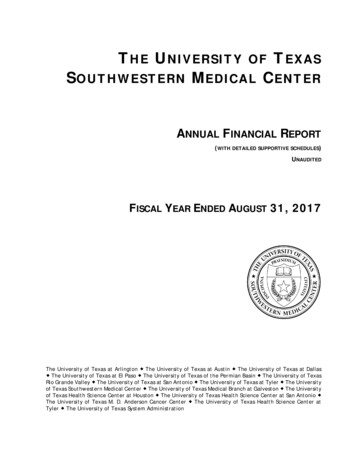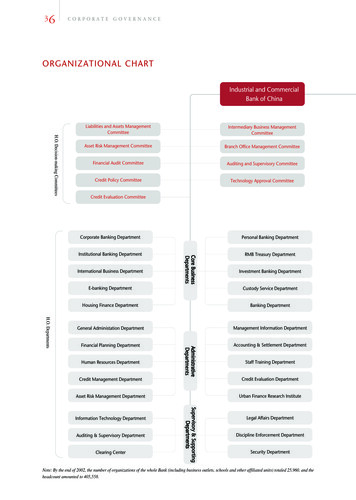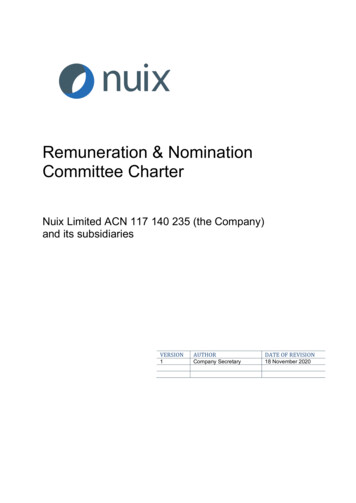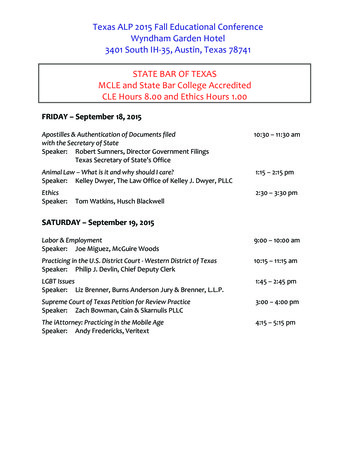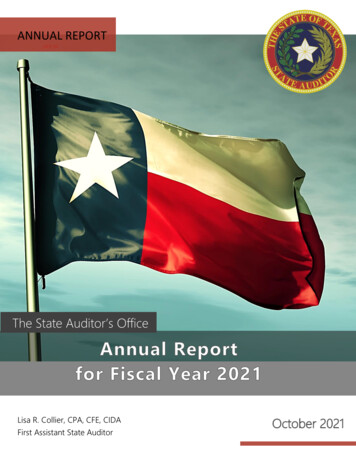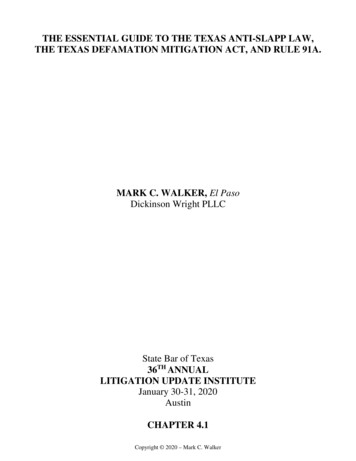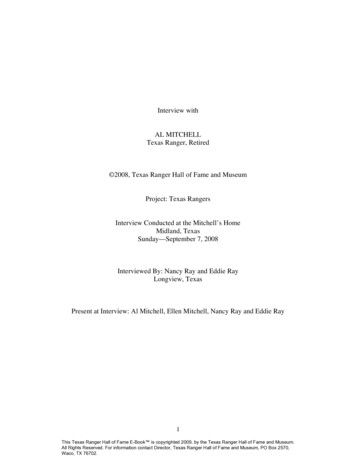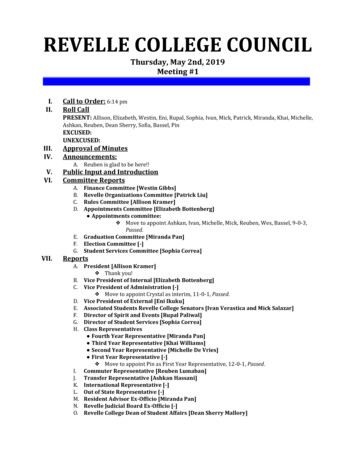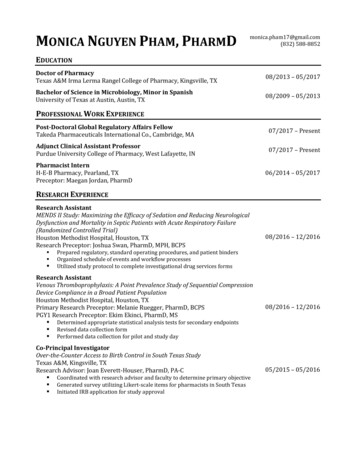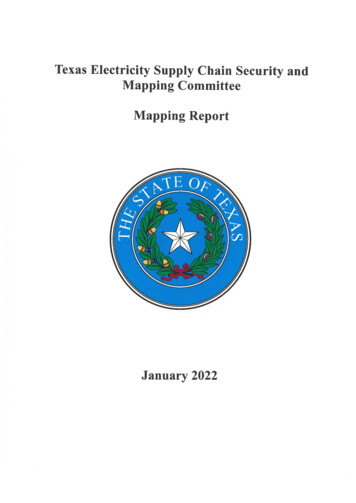
Transcription
Texas Electricity Supply Chain Security andMapping CommitteeMapping ReportJanuary 2022
MAPPING REPORTTable of ContentsI.II.IntroductionExecutive SummaryIII.Status of Mapping Electricity Supply Chain and Identifying Sources Necessary toOperate Critical Infrastructure3IV.Communication System to Ensure Electricity to Critical Infrastructure12V.Recommended Best Practices and Compliance Standards17JANUARY 2022.23ELECTRICITY SUPPLY CHAIN SECURITY ANDMAPPING COMMITTEE
MAPPING REPORTMAPPING REPORT OF THETEXAS ELECTRICITY SUPPLY CHAIN SECURITY AND MAPPING COMMITTEEIntroductionAs part of SB 3, the Legislature created the Texas Electricity Supply Chain Security andMapping Committee (the Committee). The Committee is composed of the executive directorof the Public Utility Commission of Texas (PUCT), the executive director of the RailroadCommission of Texas (RRC), the chief of the Texas Division of Emergency Management(TDEM) and the president and chief executive officer of the Electric Reliability Council ofTexas, Inc. (ERCOT). The executive director of the PUCT serves as the chair of theCommittee. Among other things, the Committee is charged with mapping the electricitysupply chain in Texas and identifying the critical infrastructure sources in the electricity supplychain.2 The electricity supply chain map must be completed no later than September 1, 2022.No later than January 1, 2022, the Committee is required to provide a report to the Governor,Lieutenant Governor, Speaker of the House of Representatives, the Legislature and the TexasEnergy Reliability Council addressing progress in fulfilling its statutory obligations.Specifically, the Mapping Report must:A.provide an overview of the Committee’s findings regarding mapping the electricitysupply chain and identifying sources needed to operate critical infrastructure;B.recommend a communication system for the PUCT, RRC, TDEM, ERCOT andcritical infrastructure sources to ensure that electricity supply is prioritized forcritical infrastructure during extreme weather events; andC.include a list of best practices and recommended oversight and compliancestandards to prepare natural gas and electric service facilities to provide service tocritical infrastructure in extreme weather events.4The Committee submits this Mapping Report in compliance with PURA §38.204(a). ThisCommittee’s work on each of these objectives is ongoing and this report outlines theCommittee’s progress to date on meeting the objectives of this statute. Although SB 3 onlyrequires the mapping report to be submitted one time, §38.203(b) requires the Committee toupdate the supply chain map at least once a year. The Committee further commits to preparean updated Mapping Report for the Legislature by January 15 of each odd-numbered year. Thisschedule corresponds to the schedule for the PUCT to file its Biennial Report as required byPURA § 12.203.2Public Utility Regulatory Act (PURA), TEX. UTIL. CODE ANN. §38.201(c) (West Supp. 2021).Id. at §38.203(a)(l) & (2).Acts 2021, 87’ Leg., R.S., ch. 426 (SB 3) §37 (eff. June 8, 2021), Tex. Sess. Law Serv. 832, 852.PUPA §38.204(a).2JANUARY 2022ELECTRICITY SUPPLY CHAIN SECURITY ANDMAPPING COMMITTEE
MAPPING REPORTII.Executive SummaryThe Committee has made substantial progress in identifying sources for informationneeded to create the electricity supply chain map. The Committee will use a combination ofexisting data from Committee member agencies and third party data to create a comprehensiveelectricity supply chain map. The initial supply chain map must be completed by September 1,2022. However, the Committee is working to complete the map well before this date.For purposes of this initial Mapping Report, the requirement to recommend acommunication system for the Committee members and critical infrastructure sources includesan update on improvements in communication and coordination among Committee membersand the electric and natural gas industries. This Report also provides an update on how each ofthe Committee members is preparing for the winter of 2021-2022.Finally, on the best practices, recommended oversight and compliance standards that mustbe addressed in this Report, the Committee has provided an update on the legislativeimplementation activities of each Committee member, including all completed and ongoingrulemakings to implement SB 3 and House Bill (HB) 3648.III.Status of Mapping Electricity Supply Chain and Identifying Sources Necessary toOperate Critical InfrastructureA.Mapping the Electricity Supply ChainThe PUCT, RRC and ERCOT have been actively working on multiple aspects of theelectricity supply chain map. Much of this work began in the summer of 2021 and is ongoing.The Committee has met monthly since August 2021. The Committee has established variousteams composed of staff members from the PUCT, RRC and ERCOT to compile the data thatwill be needed for the supply chain map. The primary Committee teams are:1)critical facilities;2)database;3)mapping; and4)weatherization.Each of these teams is led by one or more PUC staffers and includes staff from the RRCand in some cases, ERCOT. These teams have been meeting regularly since August 2021. Themapping team meets on a weekly basis. The activities of the database and mapping teams arediscussed below. Additional activities of the PUCT, RRC and ERCOT related to theidentification of critical natural gas facilities will be discussed in more detail in throughout thisReport.3JANUARY 2022ELECTRICITY SUPPLY CHAIN SECURITY ANDMAPPING COMMITTEE
MAPPING REPORTDatabase and mapping issues:Database and Information SharingThe PUCT and RRC have executed a memorandum of understanding (MOU) that willallow the agencies to share the confidential datasets needed to prepare the electricity supplychain map. The PUCT and RRC are working to add ERCOT and TDEM to the MOU. Afterall Committee members have executed the MOU, the Committee will consider allowing otheragencies that are not members of the Committee (e.g., Texas Department of Transportationand possibly the Department of Public Safety) to sign the Non-Disclosure Agreements to beable to view the electricity supply chain map and pertinent facilities as appropriate andnecessary.Mapping and IT personnel from the PUCT and RRC have agreed on a method to integrategas and electric industry information into a single database that can be used to create theelectricity supply chain map. These agencies are also actively meeting and working with gasand electric industry market participants on various data and mapping issues. The PUCT hasalso had several discussions on mapping and related information and technology (IT) issueswith ERCOT staff. Finally, the PUCT and RRC will coordinate with TDEM to ensure that theelectricity supply chain map will include all relevant information needed by TDEM at the StateOperations Center (SOC) to respond to extreme weather emergencies.Data Collection Process and MappingPUCTThe PUCT has conducted an initial inventory of its current electric facility dataset thatincludes transmission lines, electric generation facilities, and transmission substations. ThePUCT has also researched various options, including S&P Global and U.S. Department ofHomeland Security’s Infrastructure Foundation Level Data (HIFLD) and ERCOT to updatethe PUCT’s current electric facility dataset. The PUCT has received updated electric datasetsfrom several outside sources (open-source and vendor). The PUCT is currently aggregatingdata from multiple sources, including data securely provided by ERCOT, into a single, reliabledataset that can be included in the electricity supply chain map. ERCOT will update itsinformation for the PUC dataset quarterly. Updates from S&P Global and HIFLD will beincorporated as they become available. PUCT geographic information system (GIS) expertshave converted data received from ERCOT into a format that can be used with the PUCT’smapping software. The PUCT will continue a thorough gap analysis to identify informationneeded and available or needed but currently lacking to complete the electricity supply chainmap. The RRC and PUCT have agreed to securely share GIS datasets through ArcGIS online.RRCData collection for the supply chain map by the RRC will be through three main methods:4JANUARY 2022ELECTRICITY SUPPLY CHAIN SECURITY ANDMAPPING COMMITTEE
MAPPING REPORT1)data requests directly sent by the RRC to critical gas suppliers;2)the RRC’s existing data sets and;3)data received from critical gas suppliers as required under the RRC’s new criticalgas infrastructure rule discussed in more detail below.The RRC will be using its existing online filing system, RRC Online, to collect criticalcustomer information from natural gas facilities that are designated either as:1)critical gas suppliers or2)critical customers of electric utilities municipally owned electric utilities, andelectric cooperatives.Natural gas facilities that are designated as either critical gas suppliers or critical customersunder the RRC’s newly adopted Rule 3.65 will be required to submit a completed Form CI-Dand Form CI-D Attachment. The forms must include information such as facility location,contact information, gas productionlhandling volumes, and electric utility electric serviceidentifier (ESI-ID) number and information. These forms are available on the RRC’s website.The critical natural gas entities will also be required to submit a copy of the same forms to theirelectric delivery service provider via email, as required by recent amendments to PUCT’s Rule25.52.6 While the critical designation rules are in place to ensure that electric utilitieshave thecorrect information regarding natural gas facilities for purposes of planning load shed, the RRCforms will provide helpful information in the Committee’s mapping endeavors. The RRC willfacilitate access to the critical customer information by the PUCT and ERCOT as required bythe MOU terms. The RRC GIS Mapping staff has also provided transmission pipeline datasetsto PUCT staff for a proof-of-concept map layer that when finalized, will provide read-onlyaccess to members of the Committee for review. The RRC is currently compiling additionaldatasets from internal sources that will be provided to PUCT as they are completed. Each ofthese datasets will add a new feature set and increase the robustness of the supply chain map.As of November 2021, the RRC’s mapping team has developed a preliminary map forthose pipelines that directly serve a power plant, as well as a map layer for undergroundstorages.ERCOTERCOT has provided power generation facility, transmission line and substation data tothe PUCT. ERCOT will provide the PUCT updated data on a regular basis. ERCOT is alsoreviewing and preparing its digital electric facility data to be used in building the electricitysupply chain map. Much of ERCOT’s data has been designated as ERCOT Critical Energy616 Tex. Admin. Code §3.65.Id. at §25.52.JANUARY 20225ELECTRICITY SUPPLY CHAIN SECURITY ANDMAPPING COMMITTEE
MAPPING REPORTInfrastructure Information (ECEII) under the ERCOT protocols and is therefore confidential.ERCOT and the PUCT have agreed upon a process to facilitate sharing of digital facility databetween ERCOT and the PUCT.TDEMThe mapping team has met with TDEM Leadership and TDEM Operations TechnologyGIS staff to:I)introduce TDEM staff to the mapping work undertaken thus far on theelectricity supply chain map;2)underscore the importance of TDEM’s input on the final product that will beused at the SOC when the Soc is activated; and3)set-up protocols to coordinate and share GIS layers that TDEM maintains thatcan augment the electricity supply chain map.The mapping team now includes TDEM staff participating in the weekly mapping teammeeting to construct the electricity supply chain map. The PUCT soc representative will workclosely with the RRC SOC representative and TDEM to ensure the mapping team collects andincludes on the electricity supply chain map the attribute data for each piece of criticalinfrastructure that will be the most useful in an emergency.TDEM manages an enterprise GIS system that operates on the same mapping softwareplatform that the PUCT, RRC and ERCOT utilize. Going forward, this will allow TDEM toseamlessly share and collaborate GIS web maps, data, and geospatial analysis with thoseagencies during inclement weather and power outages. TDEM maintains a Common OperatingPicture (COP) Web Map Portal within its GIS system that delivers geospatial maps and datain a secure manner to Texas State Operations Center (SOC) member agencies and externalemergency management agencies.TDEM manages a crisis information management system (CIMS) that is used to manageinformation among TDEM, the Texas State Operations Center (SOC) and TDEM’s regionaland district offices and its local emergency management stakeholders. TDEM is developing aCIMS and COP web portal in FY-22 for ESF-12 ENERGY7 for managing maps, CIMs dataand analysis in one secure location for SOC support during energy related emergencyincidents.‘Emergency Management in Texas is divided into 15 Essential Functions as designated in the Texas EmergencyManagement Plan. The PUCT is the lead agency designated in the Texas Emergency Management Plan for EnergySupport Function (ESF) 12-which addresses the energy sector of the state. For more information on the PUCT’sactivities in support of ESF-12, see Attachment 1 of this Report.JANUARY 20226ELECTRICITY SUPPLY CHAIN SECURITY ANDMAPPING COMMITTEE
MAPPING REPORTTDEM is taking additional steps in fiscal year (FY)-2022 to ensure its cloud server systemmeets newly implemented standards required by Texas Government Code § 2054.003 (13) andis adding an additional data management software system to enhance access to criticalinfrastructure data.8B.Identifying Sources Needed to Serve Critical InfrastructureSB 3, sections 4 and 16, and HB 3648 enacted by the 87th Legislature require the PUCT tocollaborate with the RRC to adopt establishing a “process to designate certain natural gasfacilities and entities associated with providing natural gas in this state as critical during energyemergencies.”9 The PUCT, RRC, ERCOT and gas and electric industry market participantsworked together to establish criteria to identify critical natural gas facilities and to prioritizeelectric service to these facilities. As required by HB 364810, both the RRC and PUCT haveadopted their critical natural gas facility rules as of December 1, 2021. The details of the rulesadopted by both agencies are outlined below.RRC Rule 16 Tex. Admin. Code 3.65--Critical Designation of Natural Gas InfrastructureThe RRC has adopted a new rule on the designation of critical natural gas facilities asrequired by HB 3648 and section 4 of SB 3.” HB 3648 requires the RRC to adopt the rule nolater than December 1, 2021 12 The RRC adopted its critical designation rule on November 30,2021. Rule 3.65 implements the requirements of HB 3648 to establish a process to designatecertain natural gas facilities and entities associated with providing natural gas in this state ascritical customers or critical gas suppliers during energy emergencies.The new rule defines “energy emergency” and “critical customer information” and clarifieshow to calculate gas volumes as indicated in the rule. The rule designates the followingfacilities as “critical gas suppliers” during an energy emergency:1)gas wells producing gas more than 15 Mcf/day;2)oil leases producing casinghead gas more than 50 Mcf/day;3)gas processing plants;88TDEM’s activities in this area are governed by Chapter 20154 of the Texas Government Code. Section 2054.001states that information and information resources of the State of Texas are strategic assets belonging to the residentsof Texas and must be managed as valuable state assets.PURA §38.074(a) (West Supp. 2021).‘ Acts 2021,87’ Leg., R.S., ch. 931 (HB 3648) §3 (eff. June 8, 2021) Tex. Sess. Law Serv. 2372, 2373.See TEX. NAT. RES. CODE §81.073(a) (West Supp. 2021).12Acts 2021, 87th Leg., R.S., ch. 931 (RB 3648) §3 (eff. June 8,2021) Tex. Sess. Law Serv. 2372, 2373.7JANUARY 2022ELECTRICITY SUPPLY CHAIN SECURITY ANDMAPPING COMMITTEE
MAPPING REPORT4)natural gas pipelines and pipeline facilities including associated compressorstations and control centers;5)local distribution company pipelines and pipeline facilities including associatedcompressor stations and control centers;6)underground natural gas storage facilities;7)natural gas liquids transportation and storage facilities; and8)saltwater disposal facilities including saltwater disposal pipelines.A critical gas supplier will be required to weatherize provided other statutory requirementsare also met.The rule also defines “critical customers” which are a subset of “critical gas suppliers.”Critical customers are critical gas suppliers who need electricity provided to operate. The newRRC rule requires a critical customer to send its “critical customer” information, such asaccount number and premise identifying information, to its electric utility for load shedplanning purposes during an energy emergency.Subsection (c) of the rule allows facilities that are not designated as critical gas suppliersor critical customers to apply to be designated as critical if the facility’s operation is requiredfor another critical facility to operate. Objective evidence must be included with the applicationand the request may be approved or rejected by RRC Staff. Additionally, a facility that is notdesignated as critical in subsection (b) but is later included on the electricity supply chain mappublished by the Committee must apply to the RRC to be designated as critical.Section 4 of SB 3 states that the RRC cannot designate as critical facilities that are notprepared to operate during a weather emergency. Such a facility would require an exceptionfrom designation as a critical facility. Based on comments received, the adopted rule includesa list of facilities that are not eligible for an exception to the critical designation because of theirimportance to the natural gas supply chain. The facilities that are not eligible for a criticalfacility exception are the following:1)a facility included on the electricity supply chain map produced by the TexasElectricity Supply Chain Security and Mapping Committee;2)gas wells or oil leases producing gas or casinghead gas more than 250 Mcf/day;3)gas processing plants;4)natural gas pipelines or pipeline facilities that directly serve local distributioncompanies or electric generation;5)local distribution company pipelines or pipeline facilities;6)underground natural gas storage facilities;8JANUARY 2022ELECTRICITY SUPPLY CHAIN SECURITY ANDMAPPING COMMITTEE
MAPPING REPORT7)natural gas liquids storage and transportation facilities; and8)a saltwater disposal facility, including a saltwater disposal pipeline, that supports afacility listed in (1) through (7) above.The final rule adopted by the RRC requires operators of critical facility to provide criticalcustomer information to the RRC and the operators’ electricity utilities. The RRC will provideboth the PUCT and ERCOT with access to the critical customer information to assist withcreating the electricity supply chain map.PUCT Rule 16 Tex. Admin. Code 25.52—Reliability and Continuity of ServicePUCT Rule 16 TAC §25.52 was amended to implement HB 3648 and PURA §38.074 thatrequire the PUCT to collaborate with the RRC to establish a process to designate certain naturalgas facilities and entities associated with providing natural gas in this state as critical duringenergy emergencies.13 The rule defines the terms “critical natural gas facility” and “energyemergency” and clarifies that critical natural gas standards apply to each facility in Texasdesignated as critical customer under the RRC’s rule 16 TAC §3.65. Section 25.52 applies totransmission and distribution utilities (TDUs) municipally owned utilities (MOUs), andelectric cooperatives (Coops). Under the rule, critical natural gas facilities must provide criticalcustomer information to their respective electric delivery service providers and to ERCOT.This information must be provided by email using RRC’s form CI-D and any attachments.The PUCT must maintain a list of utility email addresses to be used to communicate criticalcustomer information. Utilities are required to provide updates to their contact informationwithin 5 business days. The rule also requires utilities to evaluate critical customer informationwithin ten days of receipt, for completeness and provide written notice to natural gas facilityoperator regarding the status of its critical designation.The utility is required to notify the operator of the natural gas facility about its criticalstatus, the date of its designation, any additional classifications assigned to the facility by theutility, and to notify the operator that its critical status does not constitute a guarantee of anuninterrupted supply of energy.Under the rule as adopted, neither a utility nor an independent system operator receivingor sending critical customer information regarding a critical natural gas facility may releasecritical customer information to any person unless authorized by the PUCT or the operator ofthe critical natural gas facility. This prohibition, however, does not apply to the release of suchinformation to the PUCT, the RRC, the utility from which the critical natural gas facilityreceives electric delivery service, the designated transmission operator, or the independent13A similar provision was included in SB 3. See TEx. NAT. RES. CODE § 81.073(a) (West Supp. 2021).9JANUARY 2022ELECTRICITY SUPPLY CHAIN SECURITY ANDMAPPING COMMITTEE
MAPPING REPORTsystem operator or reliability coordinator for the power region in which the critical natural gasfacility is located.The rule specifies that a critical natural gas facility is a critical load during an energyemergency and further requires a utility to treat a natural gas facility that has self-designatedas critical using the voluntary Application for Critical Load Serving Electric Generation andCogeneration form as a critical natural gas facility, as circumstances require.Finally, §25.52:1)requires a utility to prioritize critical natural gas facilities for continued powerdelivery during an energy emergency;2)allows a utility to use its discretion to prioritize power delivery and powerrestoration among critical natural gas facilities and other critical loads on its system,as circumstances require; and3)requires a utility to consider any additional guidance or prioritization criteriaprovided by PUCT, RRC, or the reliability coordinator for its power region toprioritize among critical natural gas facilities and other critical loads during anenergy emergency.For the winter of 2021-2022, the TDUs, MOUs and Coops will rely on the voluntary criticalload applications submitted by natural gas entities. ERCOT TDUs have advised that to preparefor the 2021-2022 winter season, they must have received critical load applications by no laterthan November 1. These critical load application requests will be incorporated into the loadshed plans of the TDUs.Electric Service to Critical Natural Gas FacilitiesSince Winter Storm URI, TDUs have received a substantial increase in the number ofregistrations from natural gas facilities, seeking to be designated as critical load. The TDUshave expressed concern that the increase in the number of critical load registrants may make itdifficult for TDUs to effectively rotate outages during a load shed event. TDUs have beenworking with natural gas industry market participants to define tiers of criticality so that duringa load shed event, TDUs will have an established hierarchy of critical infrastructure for loadshed purposes. Natural gas industry market participants, including the Texas Oil and GasAssociation (TXOGA) addressed the tiering concept for natural gas facilities in their commentson the RRC critical designation rulemaking and in the PUCT critical designation rulemaking.Based on comments received by the RRC, the Chairman of the RRC provided the Chairmanof the PUCT with a letter outlining the facilities that the RRC knows are most important to thenatural gas supply chain during an energy emergency. The PUCT will consider this input whenissuing tiering guidance pursuant to the PUCT’s jurisdiction and the requirements of SB 3 inTex. Util Code §38.074(b)(2) and (3). The PUCT will be providing guidance in January to itsregulated industry on the designation of load shed tiers during a weather emergency.10JANUARY 2022ELECTRICITY SUPPLY CHAIN SECURITY ANDMAPPING COMMITTEE
MAPPING REPORTERCOTERCOT, the PUCT and RRC have been discussing other electric/gas coordination issues.On, October 8, 2021 the RRC sent a letter to all natural gas fired power plants in Texas,requesting the name of each generating facility’s gas supplier and pipeline operator. The RRCsent this request to 54 entities that operate natural gas-fired generation plants in the state. Ofthe 54 entities that received this request, 51 generators provided responses. To date, onegenerator has failed to respond to the RRC letter. The PUCT and RRC will continue to workwith all industry participants to obtain the information necessary to complete the electricitysupply chain map.ERCOT recently issued a request to each generator requesting the name of each generator’sgas supplier. ERCOT has received this information for approximately 95% of generation unitsand will soon make this information available to the PUCT and RRC. Ultimately, the pipelineoperator and gas supplier for each gas-fired generator in Texas will be included in theelectricity supply chain map.Current Challenges Related to the Electricity Supply Chain MapThe above-discussed rules by the RRC and PUCT are expected to be very helpful to theCommittee in creating the electricity supply chain map. One challenge for the Committee willbe obtaining and mapping the electric distribution infrastructure that serves the critical naturalgas infrastructure identified in the RRC and PUCT rules. Because the PUCT does not currentlyhave ready access to electric utility distribution level mapping data, the Committee will needto obtain this information from the electric utilities that serve the critical infrastructure sources.To incorporate this information into the electricity supply chain map in an expedient manner,the Committee must provide the electric utilities with lists of premise identifiers that areassociated with the critical infrastructure sources the RRC has identified. This information willallow the electric utilities to quickly identify and provide the associated distribution levelinformation to the Committee for mapping. Under the RRC’s critical facilities rule, a naturalgas facility must, among other things, provide its premise identifier to the electric utility thatserves the facility to be considered a critical load. The RRC must share with the Committeemembers the same data it requires natural gas facilities to provide to electric utilities so thatthis information may be used to build out the electricity supply chain map and to provide themap’s end users with information relevant to maintaining electric service in an emergencyevent.TDEMA primary role of TDEM in supporting the requirements contained in SB-3 is to provideemergency management support through the resources comprised by the State OperationsCenter Emergency Support Functions (ESFs). TDEM will work with the Committee to update11JANUARY 2022ELECTRICITY SUPPLY CHAIN SECURITY ANDMAPPING COMMITTEE
MAPPING REPORTthe ESF-12 (Energy) Annex’4 to address lessons learned from the 2021 Winter Storm and addadditional agreed upon procedures for: 1) Reporting, 2) Response, and 3) Communications.The following activities have been identified and are recommended by TDEM as neededto ensure the ESF- 12 (Energy) support function and state are better prepared for future energydisruptions:1)Secure management and access to the energy critical infrastructure map databaseand map services.2)Identification of cascading impacts from the failure of key critical infrastructuresand remediation procedures and support requirements.3)Identification of logistical and other support resources needed for responding toenergy disruptions and an operational plan for staging and managing resources.4)Development of a contact database and notification system for energy relatedcritical infrastructure owners, operators, and regulators.5)An operational playbook for ESF- 12 (Energy) that includes procedures for:6)IV.i.Reporting: Procedures for utilities and regulators to report outages orimpending outages in a uniform manner.ii.Response: Procedures for requesting assistance and activating response andsupport resources for energy related critical infrastructure types, andspecific facilities.iii.Communications: Procedures for coordinating, managing, and issuing ESF12 (Energy) related communications and notifications (citizen, privatesector and governmental).On-going training and exercises for ESF-12 (Energy) related incident scenarios.Communication System to Ensure Electricity to Critical InfrastructurePURA §38.204(a)(2) requires the Mapping Committee. “to recommend a clear andthorough communication system. .to ensure that electricity supply is prioritized to [criticalinfrastructure] sources during extreme weather events.The recommended communicationsystem applies to communications among and between the PUCT, RRC, TDEM, ERCOT andcritical infrastructure sources. These entities have been working together since the passage ofSB 3 to develop a comprehensive and effective communications system to ensure electricity isprioritized to critical infrastructure during an extreme weather event. The development of this. .“For more information on this issue, see Attachment 1 of this Report, PUCTResponsibilities as a member
As part of SB 3, the Legislature created the Texas Electricity Supply Chain Security and Mapping Committee (the Committee). The Committee is composed of the executive director of the Public Utility Commission of Texas (PUCT), the executive director of the Railroad Commission of Texas (RRC), the chief ofthe Texas Division Emergency Management


